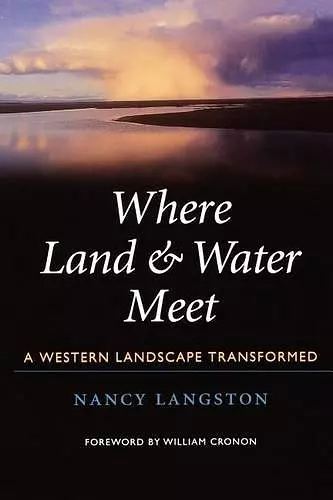Where Land and Water Meet
A Western Landscape Transformed
Format:Paperback
Publisher:University of Washington Press
Published:9th Jan '06
Currently unavailable, and unfortunately no date known when it will be back

A case study of one of the most important wildlife refuges in America
Water and land interrelate in surprising and ambiguous ways, and riparian zones, where land and water meet, have effects far outside their boundaries. Using the Malheur Basin as a case study, this book explores the ways people envisioned boundaries between water and land, the ways they have altered these places, and the often unintended results.
Water and land interrelate in surprising and ambiguous ways, and riparian zones, where land and water meet, have effects far outside their boundaries. Using the Malheur Basin in southeastern Oregon as a case study, this intriguing and nuanced book explores the ways people have envisioned boundaries between water and land, the ways they have altered these places, and the often unintended results.
The Malheur Basin, once home to the largest cattle empires in the world, experienced unintended widespread environmental degradation in the late nineteenth and early twentieth centuries. After establishment in 1908 of Malheur National Wildlife Refuge as a protected breeding ground for migratory birds, and its expansion in the 1930s and 1940s, the area experienced equally extreme intended modifications aimed at restoring riparian habitat. Refuge managers ditched wetlands, channelized rivers, applied Agent Orange and rotenone to waterways, killed beaver, and cut down willows. Where Land and Water Meet examines the reasoning behind and effects of these interventions, gleaning lessons from their successes and failures.
Although remote and specific, the Malheur Basin has myriad ecological and political connections to much larger places. This detailed look at one tangled history of riparian restoration shows how—through appreciation of the complexity of environmental and social influences on land use, and through effective handling of conflict—people can learn to practice a style of pragmatic adaptive resource management that avoids rigid adherence to single agendas and fosters improved relationships with the land.
"In Where Land and Water Meet, environmental historian Nancy Langston delivers an intricate, well-researched exposé of how changes in human values and social goals have informed land use and land management decisions at the present-day Malheur National Wildlife Refuge..[T]his is an excellent example of environmental history by an experienced researcher and writer."
* Ecological Restoration *"Where Land and Water Meet is a thoughtful journey along the borders between land and water, between the human and the natural. A timely examination of the creation and evolution of Malheur National Wildlife Refuge, it coincides with the centennial of the refuge system and more recent conflicts involving the water resources of the Pacific Northwest."
* Environmental History *"A sophisticated yet accessible analysis of the intersection of nature and culture. More importantly, however, it moves beyond simple criticisms of the problems inherent in wildlife and natural resource management and advances a nuanced program for those invested in land management, outdoor recreation, farming, ranching, and the environment."
* H-Net Book Review *"A scholarly gem linking past, present, and future land policies..[T]his much needed case history effectively links the management history of wetlands with modern theories of landscape ecology and adaptive management. It is concise, well written, and compelling."
* Pacific Northwest Quarterly *"As with her previous work, Langston demonstrates a knack for using detailed case studies to reflect on changes throughout the West, and indeed, the relationship between people and the natural world. Though trained in ecology, Langston is also a skilled historian and graceful writer. Environmental historians pride themselves on their ability to synthesize scientific and historical knowledge. Once again, Langston demonstrates that she does this better than almost anyone in the field."
* Journal of the History of BioloISBN: 9780295984995
Dimensions: unknown
Weight: 386g
268 pages